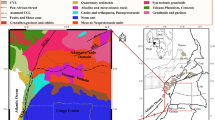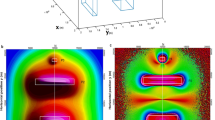Abstract
The purpose of the present study is to map the structural lineaments and fracture zone around the Central Indian Ridge (10°S–21°S) using EIGEN 6C4 Bouguer gravity data. This would help to better understand the evolution of the Indian Ocean Triple Junction (IOTJ), Central Indian Ridge (CIR) and the Ocean floor in the vicinity. In this study, a comparison of three different edge detection techniques have been made to validate the TAHG (tilt angle of total horizontal gradient) and the THVH (Tilt angle of vertical derivative of total horizontal gradient) edge detection techniques over the rudimentary total horizontal derivative (THD) technique. Synthetic model study was performed considering the major problems of the standard edge detection process. Results of the three edge detection techniques were compared critically and validated with the satellite-derived EIGEN 6C4 Bouguer gravity data. The lineaments exhibit NE-SW and NNW-SSE trends over the ocean. The NE-SW trend represents the current spreading direction of the CIR (Central Indian Ridge), whereas NNW-SSE trend representing the lineaments formed due to ridge jump during magnetic anomaly 20 and 18.
Similar content being viewed by others
References
Braitenberg, C. and Ebbing, J. (2009a) New insights into the basement structure of the west-Siberian basin from forward and inverse modelling of GRACE satellite gravity data. Jour. Geophys. Res., v.114, B06402, doi:https://doi.org/10.1029/2008JB005799.
Braitenberg, C. and Ebbing, J. (2009b) The GRACE-satellite gravity and geoid fields in analysing large scale, cratonic or intra-cratonic basins. Geophys. Prospect, v.57, pp.559–571.
Braitenberg, C., Mariani, P., Ebbing, J. and Sprlak, M. (2011) The enigmatic Chad lineament revisited with global gravity and gravity-gradient fields. Geol. Soc. London Spec. Publ., v.357, pp.329–341.
Casas, A.M., Cortes, A.L., Maestro, A., Soriano, M.A., Riaguas, A. and Bernal, J. (2000) LINDES:a program for lineament length and density analysis. Computer and Geosciences, v.26(9&10), pp.1011–1022.
Cochran, J.R., Kurras, G.J., Edwards, M.H. and Coakley, B.J. (2003) The Gakkel Ridge: Bathymetry, gravity anomalies, and crustal accretion at extremely slow spreading rates. Jour. Geophys. Res., Solid Earth, v.108, pp.1978–2012.
Cordell, L. (1979) Gravimetric expansion of graben faulting in Santa Fe Country and Espanola Basin, New Mexico. Geological society Guidebook, 30th field conference, New Mexico, pp.59-64.
DeMets, C., Gordon, R.G. and Vogt, P. (1994) Location of the Africa-Australia-India triple junction and motion between the Australian and Indian plates: Results from an aeromagnetic investigation of the Central Indian and Carlsberg ridges. Geophys. Jour. Internat., v.119, pp.893–930.
DeMets, C., Gordon, R.G., Argus, D. and Stein, S. (1990) Current plate motions. Geophys. Jour. Internat., v.101, pp.425–478.
Dick, H.J., Lin, J. and Schouten, H. (2003) An ultraslow-spreading class of ocean ridge. Nature, v.426, pp.405–412.
Ferreira, F., Souza, J., Bongiolo, A. and Castro, L. (2013) Enhancement of the total horizontal gradient of the magnetic anomalies using the tilt angle. Geophysics, v.78, pp.J33–J41, doi: https://doi.org/10.1190/geo2011-0441.1
Fisher, R. L., Sclater, J. G. and McKenzie, D. (1971) Evolution of the Central Indian Ridge, Western Indian Ocean. Geol. Soc. Amer. Bull., v.82(3), pp.553–562.
Förste, C., Bruinsma, S.L., Abrikosov, O., Lemoine, J.-M. Marty, J. C. Flechtner, F. Balmino, G., Barthelmes, F. and Biancale, R. (2014) EIGEN-6C4 The latest combined global gravity field model including GOCE data up to degree and order 2190 of GFZ Potsdam and GRGS Toulouse, GFZ Data Services, https://doi.org/10.5880/icgem.2015.1
Grauch, V.J.S. and Cordell, L. (1987) Limitation of determining density or magnetic boundaries from the horizontal gradient of gravity or pseudogravity data. Geophysics, v.52, pp.118–121.
Honsho, C., Tamaki, K., and Fujimoto, H. (1996) Three dimensional magnetic and gravity studies of the rodriguez triple junction in the Indian Ocean. Jour. Geophys. Res. v.1011, pp.15837–15848, https://doi.org/10.1029/96JB00644
Koike, K., Nagano, S. and Ohmi, M. (1995) Lineament analysis of satellite images using a segment tracing algorithm (STA). Computer and Geosciences, v.21(9), pp. 1091–1104.
Kostelecky, J., Klokocnik, J., Bucha, B., Bezdek, A., and Foerste, C. (2015) Evaluation of gravity field model EIGEN 6C4 by means of various functions of gravity potential, and by GNSS/levelling. Geoinformatics, FCE CTU. 14.7.10.1431/gi.14.1.1.
Kumar, U., Pal, S.K., Sahoo, S.D., Narayan, S., Mondal, S. and Ganguli S.S. (2018) Lineament Map** over Sir Creek Offshore and its Surroundings using High Resolution EGM2008 Gravity Data: An Integrated Derivative Approach. Jour. Geol. Soc. India, v.91(6), pp.671–678.
Kuo, B. Y. and Forsyth, D. W. (1988) Gravity anomalies of the ridge-transform system in the South Atlantic between 31° S and 34.5° S: upwelling centers and variations in crustal thickness. Marine Geophys. Res., v.10(3–4), pp.205–232.
Lin, J., Purdy, G., Schouten, H., Sempere, J. and Zervas, C. (1990) Evidence from gravity data for focused magmatic accretion along the Mid-Atlantic Ridge. Nature, v.344, pp.627–632.
Majumdar, T.J., Mohanty, K.K. and Srivastava, A.K. (1998) On the utilization of ERS-1 altimeter data for offshore oil exploration. Internat. Jour. Remote Sens, v.19(10), pp.1953–1968.
McKenzie, D. P. (1967) Some remarks on heat flow and gravity anomalies. Jour. Geophys Res., v.72 (24), pp.6261–6273.
McKenzie, D. P. and Sclater J. G. (1971) The evolution of the Indian Ocean since the Late Cretaceous. Geophys. Jour. Roy. Astr. Soc., v.25, pp.437–528.
Mellor, S.H. (1998) The geochemistry and petrology of the Rodrigues Ridge (Western Indian Ocean), PhD Thesis, University of Greenwich.
Michael, P., Langmuir, C., Dick, H., Snow, J., Goldstein, S., Graham, D., Lehnert, K., Kurras, G., Jokat, W. and Mühe, R. (2003) Magmatic and amagmatic seafloor generation at the ultraslow-spreading Gakkel Ridge, Arctic Ocean. Nature, v.423, pp.956–961.
Miller, H.G., and Singh, V. (1994) Potential field tilt-a new concept for location of potential field sources. Jour. Appld. Geophys., v.32, pp.213–217.
Mitchell, N.C. and L.M. Parson, (1993) Tectonic evolution of the Indian triple junction, anomaly 6 to present. Jour. Geophys. Res., v.98, pp.1793–1812.
Narayan, S., Sahoo, S. D., Pal, S. K., Kumar, U., Pathak, V. K., Majumdar, T. J. and Chouhan, A. (2016) Delineation of structural features over a part of the Bay of Bengal using total and balanced horizontal derivative techniques. Geocarto Internat., v.32(4), pp.351–366.
Pak, S.J., Moon, J.W., Kim, J., Chandler, M., Kim, H.S., Son, J., Son, S.K., Choi, S. K., and Edward, T.B. (2017) Widespread tectonic extension at the Central Indian Ridge between 8°S and 18°S. Gondwana Res., v.45. https://doi.org/10.1016/j.gr.2016.12.015.
Pal, S. K., Majumdar, T. J., Pathak, V. K., Narayan, S., Kumar, U. and Goswami, O. P. (2016a) Utilization of high-resolution EGM2008 gravity data for geological exploration over the Singhbhum-Orissa Craton, India. Geocarto Internat., v.31(7), pp.783–802.
Pal, S. K., Narayan, S., Majumdar, T. J., and Kumar, U. (2016b) Structural map** over the 85° E Ridge and surroundings using EIGEN6C4 highresolution global combined gravity field model: an integrated approach. Mar. Geophys. Res., v.37(3), pp.159–184.
Parson, L.M., Patriat, P., Searle, R.C. and Briais, A.R. (1993) Segmentation of the Central Indian Ridge between 12°12 ?S and the Indian Ocean triple junction. Mar. Geophys. Res., v.15, pp.265–282.
Patriat, P. and Segoufin, J. (1987) Reconstruction of the central Indian ocean, Tectonophysics, v.155, 211–234.
Rajesh, S. and Majumdar, T.J. (2004) Generation of 3-D geoidal surface of the Bay of Bengal lithosphere and its tectonic implications. Internat. Jour. Remote Sens., v.25(15), pp.2897–2902.
Rajesh, S. and Majumdar, T.J. (2010) Geoid height versus topography of the northern Ninetyeast Ridge: Implications on crustal compensation. Mar. Geophys. Res., v.30 pp.251–264, doi: https://doi.org/10.1007/s11001-010-9088-7.
Rajesh, S., Majumdar, T.J. and Krishna, K.S. (2015) Lithospheric stretching and the long wavelength free-air gravity anomaly of the Eastern Continental Margin of India and the 85oE Ridge, Bay of Bengal. India. Jour. Geo-Mar. Sci., v.44(6), pp.783–794.
Sandwell, D.T., Müller, R.D., Smith, W.H.F., Garcia, E. and Francis, R. (2014) New global marine gravity model from Cryosat-2 and Jason-1 reveals buried tectonic structure. Science, v.346, pp.65, doi: https://doi.org/10.1126/science.1258213
Schlich, R. (1982) The Indian Ocean: Aseismic ridges, spreading centers, and oceanic basins; In: The Ocean Basins and Margins (eds) Nairn A E M and Stehli F G, vol. 6, The Indian Ocean, Plenum, New York, pp.51-147.
Searle, R. (2013) Mid-Ocean Ridges. Cambridge University Press, 318p.
Sempéré, J.C., Lin, J., Brown, H.S., Schouten, H. and Purdy, G. (1993) Segmentation and morphotectonic variations along a slow-spreading center: The Mid-Atlantic Ridge (24°00′ N-30°40′ N). Mar. Geophys. Res., v.15, pp.153–200.
Sempéré, J.C., Purdy, G.M. and Schouten, H. (1990) Segmentation of the Mid-Atlantic Ridge between 24°N and 30°40′N. Nature, v.344, pp. 427–431.
Smith, D.K. and Cann, J.R. (1993) Building the crust at the Mid-Atlantic Ridge. Nature, v.365, pp.707–715.
Vaish, J. and Pal, S.K. (2015) Geological map** of Jharia Coalfield, India using GRACE EGM2008 gravity data: a vertical derivative approach. Geocarto Int., v.30(4), pp.388–401,DOI:https://doi.org/10.1080/10106049.2014.905637.
Wessel, P., Matthews, K. J., Müller, R. D., Mazzoni, A., Whittaker, J. M., Myhill, R. and Chandler, M.T. (2015), Semiautomatic fracture zone tracking. Geochem. Geophys. Geosyst., v.16, pp.2462–2472, doi:https://doi.org/10.1002/2015GC005853.
Xu, Z., Peng, Y., Rui, T., Yang, X. and Zhao, C.J. (2015) Edge enhancement of potential field data using enhanced tilt angle. Exploration Geophysics, v.46(3), pp.276–283, DOI: https://doi.org/10.1071/EG13104.
Zhao, Y.B., He, Z.W., Ni, Z.Y., Chen, H.Q. and Zhang, D.H. (2009) The correlation study of lineaments and geological disasters in **n** country, Yunnan Provinces. Chinese Jour. Geol. Hazard and Control, v.20, pp.70–73.
Acknowledgements
We are thankful to the Dr. B. Mahabaleswar, Editor-in-Chief; Dr. Pradeep Srivastava, Associate Editor, Journal of the Geological Society of India and the anonymous reviewers for their valuable suggestions and timely review of the manuscript. We wish to thank International Centre for Global Earth Models (ICGEM) for providing EIGEN6C4 gravity data. We are also thankful to the Director, IIT (ISM), Dhanbad and Head, Dept. of App. Geophysics, IIT (ISM), Dhanbad for their keen interest in this study. Authors are thankful to ISRO, Dept. of space, Govt. of India for funding RESPOND project No. ISRO/RES/630/2016-17.
Author information
Authors and Affiliations
Corresponding author
Rights and permissions
About this article
Cite this article
Sahoo, S.D., Pal, S.K. Map** of Structural Lineaments and Fracture Zones around the Central Indian Ridge (10°S–21°S) using EIGEN 6C4 Bouguer Gravity Data. J Geol Soc India 94, 359–366 (2019). https://doi.org/10.1007/s12594-019-1323-5
Received:
Accepted:
Published:
Issue Date:
DOI: https://doi.org/10.1007/s12594-019-1323-5




